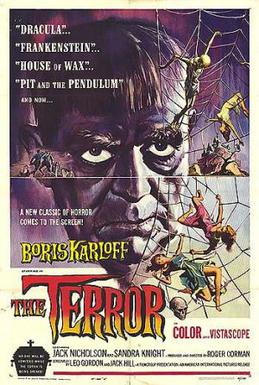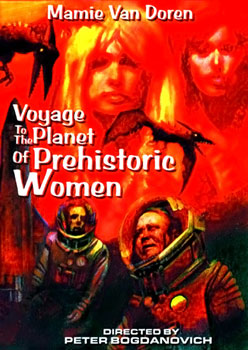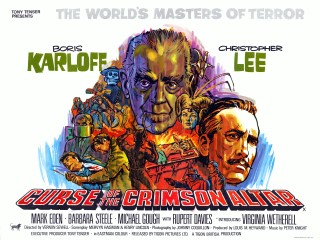
William Henry Pratt, known professionally as Boris Karloff and occasionally billed as Karloff the Uncanny, was an English actor. His portrayal of Frankenstein's monster in the horror film Frankenstein (1931) established him as a horror icon, and he reprised the role for the sequels Bride of Frankenstein (1935) and Son of Frankenstein (1939). He also appeared as Imhotep in The Mummy (1932), and voiced the Grinch in, as well as narrating, the animated television special of Dr. Seuss' How the Grinch Stole Christmas! (1966), which won him a Grammy Award.

Roger William Corman is an American film director, producer, and actor. Known under various monikers such as "The Pope of Pop Cinema", "The Spiritual Godfather of the New Hollywood", and "The King of Cult", he is known as a trailblazer in the world of independent film. Many of Corman's films are low-budget cult films including some which are adapted from the tales of Edgar Allan Poe.

The Raven is a 1963 American comedy gothic horror film produced and directed by Roger Corman. The film stars Vincent Price, Peter Lorre, and Boris Karloff as a trio of rival sorcerers. The supporting cast includes Jack Nicholson as the son of Lorre's character.
Count Orlok, commonly but erroneously known as Nosferatu, is a fictional character who appears in the silent film Nosferatu, eine Symphonie des Grauens (1922) and in its remake Nosferatu (2024), which is based on Bram Stoker's character Count Dracula.

Samuel Zachary Arkoff was an American producer of B movies.

Boris Karloff (1887-1969) was an English actor. He became known for his role as Frankenstein's monster in the 1931 Frankenstein, leading to a long career in film, radio, and television.

The Terror is a 1963 American independent horror film produced and directed by Roger Corman. The film stars Boris Karloff and Jack Nicholson, the latter of whom portrays a French officer who is seduced by a woman who is also a shapeshifting devil.

The Old Dark House is a 1932 American pre-Code comedy horror film directed by James Whale. Based on the 1927 novel Benighted by J.B. Priestley, the film features an ensemble cast that includes Boris Karloff, Melvyn Douglas, Gloria Stuart, Charles Laughton, Lilian Bond, Ernest Thesiger, Raymond Massey and Eva Moore. Set in interwar Wales, the film follows five travellers who seek shelter from a violent storm in the decaying country house home of the eccentric Femm family.

Voyage to the Planet of Prehistoric Women is a 1968 American science fiction film, one of two films whose footage was taken from the 1962 Soviet SF film Planeta Bur for producer Roger Corman. The original film was scripted by Alexander Kazantsev from his novel and directed by Pavel Klushantsev. This adaptation, made by Peter Bogdanovich, who chose not to have his name credited on the film, included new scenes added that starred Mamie Van Doren. The film apparently had at least a limited U.S. release through American International Pictures, but became better known via subsequent cable TV showings and home video sales. The film contains no footage from Planeta Bur that was not used in the earlier Voyage to the Prehistoric Planet (1965).

The Comedy of Terrors is a 1963 American International Pictures horror comedy film directed by Jacques Tourneur and starring Vincent Price, Peter Lorre, Basil Rathbone, Boris Karloff and Joe E. Brown in his final film appearance. It is a blend of comedy and horror that features several cast members from Tales of Terror, a 1962 film also released by AIP.

The Haunted Palace is a 1963 horror film released by American International Pictures, starring Vincent Price, Lon Chaney Jr. and Debra Paget, in a story about a village held in the grip of a dead necromancer. The film was directed by Roger Corman and is one of his series of eight films largely based on the works of American author Edgar Allan Poe.

Tim O'Kelly was an American actor best known for playing the homicidal sniper in Peter Bogdanovich's film Targets (1968).

Transylvania Twist is a 1989 comedy film that parodies horror films. Originally released by Concord Production Inc., this film is distributed on home video by Metro-Goldwyn-Mayer. In the film Angus Scrimm reprises his role of the "Tall Man" from the Phantasm films, as a parody. The humor of the film is most often said to be in the style of Airplane!, and Mel Brooks comedies. It occasionally breaks the fourth wall rule with characters looking at the camera, and one even saying "I'm in the wrong movie". The film's main theme has been released on a variety of albums, it and the entire soundtrack was released on CD and as a direct download in the year 2010, twenty-one years after the movies initial release.

Curse of the Crimson Altar is a 1968 British horror film directed by Vernon Sewell and starring Christopher Lee, Boris Karloff, Barbara Steele and Mark Eden. The film was produced by Louis M. Heyward for Tigon British Film Productions. The screenplay, by Doctor Who writers Mervyn Haisman and Henry Lincoln, was based (uncredited) on the short story "The Dreams in the Witch House" by H. P. Lovecraft. This film also featured the final British film appearance of Karloff.

The Incredible Invasion, also known as Alien Terror, is a 1968 Mexican science fiction film directed by Luis Enrique Vergara. It stars Boris Karloff, Yerye Beirute and Enrique Guzmán. It is the last film Karloff worked on before his death in 1969. It was filmed in May 1968, but was only released theatrically in 1971, 2 years after Karloff had died.

House of Evil a.k.a. Dance of Death, is a 1968 Mexican horror film directed by Luis Enrique Vergara and Jack Hill. It stars Boris Karloff and Julissa. It was filmed in May 1968, but released theatrically in 1972, three years after Karloff had died.

Fear Chamber, also released as The Torture Zone, is a 1968 Mexican horror film directed by Juan Ibáñez and starring Boris Karloff and Julissa. It was filmed in May 1968, but was only released theatrically in 1971, 2 years after Karloff had died.
Scott Allen Nollen is an American author known for writing about the history of film, music, literature and African American studies. He was born on April 2, 1963, in Harlan, Iowa. His father, Harold N. Nollen, served in the United States Coast Guard prior to running a successful petroleum distribution business, to which his mother, Shirley A. (Stoltz) Nollen, also contributed. Nollen was educated at the University of Iowa (1984-1989), where he received Bachelor's Degrees in Broadcasting and Film and Honors History, Phi Beta Kappa, and a Master's Degree in U.S., Modern European and African-American History. From 1991 to 2001, he served as an archivist and historian for the National Archives and Records Administration.

Nancy Hsueh was an American actress. She was one of the first Asian American actresses to have a leading role in a U.S. television series, Love is a Many Splendored Thing (1967), regarded as the first American soap opera to portray an interracial relationship between an Asian woman and a white man. She also appeared in films such as War Hunt (1962), Cheyenne Autumn (1964), and Targets (1968).

Boris Karloff: The Man Behind the Monster is a 2021 American-British documentary film about the life and career of English actor Boris Karloff, who was known for his roles in horror films. The documentary was directed & written by Thomas Hamilton and co-produced with Ron MacCloskey. The film features interviews with such subjects as Guillermo del Toro, John Landis, Joe Dante, Christopher Plummer, Peter Bogdanovich, Ron Perlman, Leonard Maltin, Christopher Frayling, Sara Karloff, Roger Corman, Dick Miller, biographer Stephen Jacobs with artwork specially created by artist Joe Liotta, and music score by Laura Forrest Hay.


















